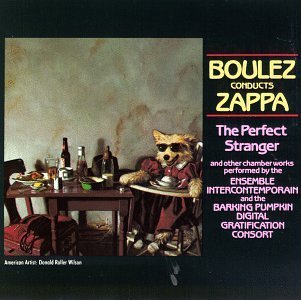Heralded by a doorbell, Boulez and the Ensemble InterComtemporain dive into the title track, and wander around for about 12 minutes to illustrate an encounter between a housewife and an industrial vacuum cleaner salesman, the product being one of Frank’s favorite appliances. (By the way, the liner notes call these all “dance pieces”, as if we could imagine the choreography as described therein.) “Naval Aviation In Art?” expands the piece already heard on Orchestral Favorites, downplaying the solo violin but retaining the suspense. They also provide the first official appearance of “Dupree’s Paradise”, an instrumental that had been around since before the Roxy shows, and delivered with little of the jazz overtones heard on other versions, but resolving well.
The other half of the album is performed by what’s called the Barking Pumpkin Digital Gratification Consort, which was actually Frank composing music and performing it using the Synclavier, a computerized system that made classical transcription a zillion times easier and faster, and reproduced it flawlessly. With this machine, Frank’s big beef about being at the mercy of prima donnas and insufficiently skilled musicians was solved. Well, mostly; the Synclavier wasn’t exactly a digital sampler, so music performed on or by it risked sounding canned, much like Switched-On Bach by Wendy Carlos and sundry. That said, “The Girl In The Magnesium Dress” is based around the sound of a vibraphone over electric piano tones, both played at high speed. “Love Story” is more frenetic and brief, sounding more like a bunch of keyboards, while “Outside Now Again” slows down a theme from Joe’s Garage that sounds very close to “Duke Of Prunes”, noodling away on top of it. “Jonestown” closes the album, essentially his aural vision of the horror in Guyana used to comment on religion, organized or not, as a whole. It’s highly disturbing, but effective.
As with his other albums in the classical vein, one’s appreciation for The Perfect Stranger will depend mostly on one’s tolerance for orchestral instruments, and if the absence of vocals and guitar solos is a factor in any way. The addition of the Synclavier makes it very much a historical entry in the canon, as he would continue to both explore its capabilities and release his results.
Boulez Conducts Zappa The Perfect Stranger (1984)—3

No comments:
Post a Comment